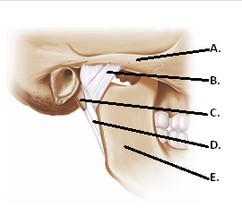Which bone bears the mandibular fossa?
A. Maxilla
B. Temporal
C. Zygomatic
D. Mandible
E. Frontal
B
You might also like to view...
Sarah is resting in a chair for a long period of time; her calf and thigh muscles are totally relaxed. Next to her, Priya is also resting in a chair, but she is wiggling, kicking, tapping, and vibrating her legs; resulting in an pattern where her calf and thigh muscles are alternating between relaxed and contracted states. If all else is equal, who has the higher stroke volume, Sarah or Priya?
A. Sarah and Priya have the same stroke volume because they are both seated. B. Sarah has a higher stroke volume. C. Priya has a higher stroke volume. D. No significant difference in the stroke volume between Sarah and Priya can be predicted based on this information.
List the three structural categories of joints and briefly describe the criteria used for structural classification of joints
What will be an ideal response
A thick midline ridge in the thyroid cartilage that is sometimes referred to as the Adam's apple is technically named the
A) Adam's apple. B) epiglottis. C) laryngeal prominence. D) glottis. E) cricoid extension
 The figure illustrates structures in the right temporomandibular joint (lateral view). What does "E" represent?
The figure illustrates structures in the right temporomandibular joint (lateral view). What does "E" represent?
A. Stylomandibular ligament B. Mandible C. Styloid process D. Lateral ligament E. Zygomatic arch